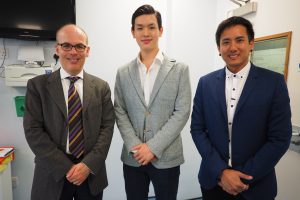By Professor Simon Taylor-Robinson, Consultant Hepatologist and Professor of Translational Medicine at Imperial College London

Cholangiocarcinoma is a rare primary malignancy arising from cholangiocytes, the endothelial lining of the biliary ducts, with an incidence 2500 cases of per annum in the UK. The only option for cure is surgical resection, but cholangiocarcinoma usually presents late when it grows sufficiently to block the drainage of bile from the liver, presenting with jaundice. By this point it is often irresectable, and palliative management includes holding open the ducts with stents to prevent blockage, and chemotherapy. One-year survival is only 5%.
The incidence of this insidious disease is increasing, and earlier diagnosis and better treatment are urgently required. Aetiological factors are thought to include exposure of the endothelium to carcinogenic compounds, and increased mutation induced by chronic inflammation, which may explain the association of chronic infection/gallstones, anatomical abnormalities, intrabiliary parasites, chronic biliary inflammatory disease. However, many patients do not have any identifiable risk factors.
The Lead Investigators in our research, as well myself, include Dr Shahid Khan, Honorary Clinical Senior Lecturer, Adjunct Reader from the Faculty of Medicine, Faculty of Medicine Centre and Professor Richard Syms from the Faculty of Engineering, Department of Electrical and Electronic Engineering. Our work aims to tackle cholangiocarcinoma in five main areas:
1) Novel biomarkers for cholangiocarcinoma. This takes advantage of the large numbers of patients with hepatobiliary malignancies including cholangiocarcinoma who are managed through the tertiary referral HPB services provided at Hammersmith Hospital, and utilises scientific expertise and infrastructure on both the Hammersmith and South Kensington sites. As part of a UKCRN-adopted programme we are establishing a biobank of body fluids from patients with various hepatobiliary malignancies in collaboration with other groups. We are applying metabonomic and proteomic analysis to blood, bile and urine samples to identify novel biomarkers for cholangiocarcinoma diagnosis and prognostication.
2) Genetic risk factors for cholangiocarcinoma. We have established a bank of DNA samples from patients with cholangiocarcinoma and with related diseases. DNA SNP analysis has demonstrated association of mutations in bilary transporters with development of cancer. Further analysis continues.
3) Epidemiology of Cholangiocarcinoma. It is known that the diagnosed incidence of cholangiocarcinoma is increasing. Work in our group in collaboration with Mireille Toledano (School of Public Health) has demonstrated the need for careful re-evaluation of these data as the real trend is obscured by changes in disease coding practice. Epidemiological work is continuing to identify associated factors which may give insight into cause, and assist in service planning.
4) Improving imaging in Cholangiocarcinoma. Current imaging techniques include ultrasound, MRI and CT scanning. However, optimising patient staging to accurately identify those who may benefit from resection or other therapies demands greater imaging resolution than these techniques can provide. In a collaborative project with the Richard Syms in the Engineering Faculty, we are
developing an MRI probe which could be placed inside the bile ducts to give fine detail on tumour anatomy and its breach of the ductal layers as it progresses. This has led to the development of novel coil technologies by our collaborating partners and offers exciting prospects for the future in this and other applications.
5) International and Domestic Collaborations. In other countries infestation with biliary parasites is associated with a higher incidence of cholangiocarcinoma. We have previous, ongoing and evolving collaborations with Thailand, Egypt, and Bangladesh with the aim of comparing samples from fluke-related disease with our own cohort to identify differentiating factors. We also have collaboration with the Mayo Clinic and leading Norwegian researchers. Within the UK we have existing collaborations with Oxford and UCL, and are developing new relationships as part of the UKCRN scheme, with 6 new centres currently agreed